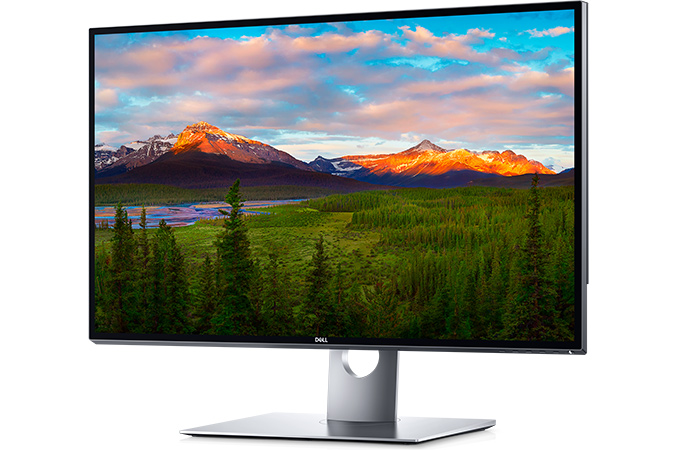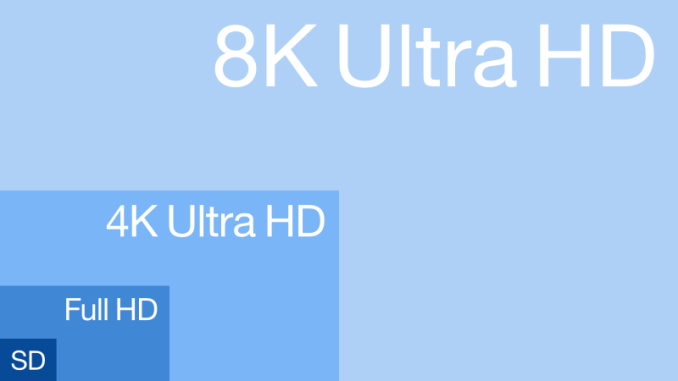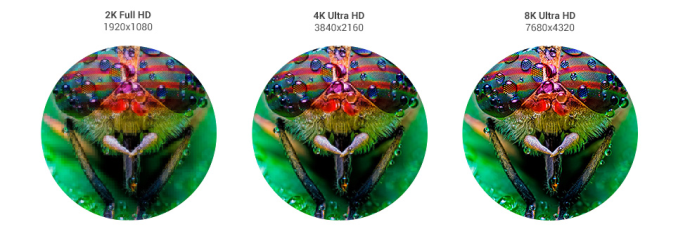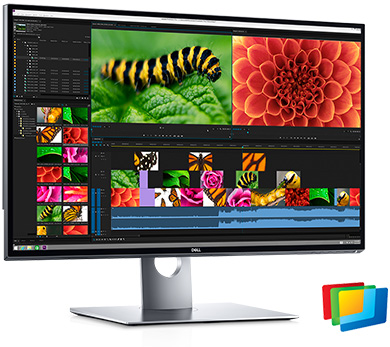Dell’s 32-inch 8K UP3218K Display Now For Sale: Check Your Wallet
by Ian Cutress on March 24, 2017 7:55 AM EST
Back at CES in January, Dell announced the next step in personal screen resolution advancements. The recent rise of ‘4K’ (or more accurately, Ultra-HD at 3840x2160) monitors has shown that there is a demand for high resolution interfaces beyond a smartphone. Back when UHD monitors in a 16:9 format launched en masse, prices were high ($3500-5000+) and stocks were limited – I remember back in 2013 testing the Sharp 32-inch 4K display at a vendor in Taiwan several years ago in one of the first pieces to test 4K/UHD gaming. The fact that this was the only UHD monitor that GIGABYTE had in their HQ was a testament to how new the technology was. Now, 24-inch UHD displays can be had for as little as $350. We may see history repeat itself with 8K monitors from today.
As always, the first Dell monitors off the production line are designed to be high-end professional monitors. The UP3218K goes in at higher than average specifications, such as 1300:1 contrast ratio, 400 nits brightness, but also offers 100% AdobeRGB, 100% RGB and 98% DCI-P3. The UP3218K is part of Dell’s UltraSharp range, which means we should expect the monitor to be color calibrated out of the box to within a given dE value, typically dE < 3.
| Specifications Dell UltraSharp UP3218K |
||
| Panel | 31.5" IPS | |
| Resolution | 7680 × 4320 | |
| Brightness | 400 cd/m² | |
| Contrast Ratio | 1300:1 | |
| Refresh Rate | 60 Hz | |
| Viewing Angles | 178°/178° horizontal/vertical | |
| Color Saturation | 100% Adobe RGB 100% sRGB 98% DCI-P3 100% Rec 709 |
|
| Display Colors | 1.07 billion | |
| Inputs | 2 × DisplayPort 1.4 | |
| Connectivity | USB 3.0 Hub: 3x USB 3.0-A Downstream 1x USB 3.0-A Downstream (power) USB 3.0-B Upstream Audio Line-Out |
|
| Rated Power Consumption | 87 W | |
Naturally a question pops up as to how to hook an 8K display up, especially will all the bells and whistles. The display uses two DP1.4 inputs to provide enough bandwidth, which means that we’re typically dealing with the internal controller stitching together two 3840x4320 displays, similar to how the early 4K monitors did (but with a few more years experience on how to do it). It is possible that Dell supports a single DP1.4 cable, which would most likely use Display Stream Compression 1.2 to offer a visually lossless image as a single panel, however one may suspect that given the target market for this panel, a truly lossless image is probably preferred, even when dealing with two input streams.
Overall an 8K monitor offers 33.2 megapixels of coverage, which in a 32-inch (31.5-inch) form factor gives 280 pixels per inch. 33.2 megapixels is four times that of UHD, which is 8.3 megapixels. Users wanting to play some AAA titles at 8K on this beast are going to run into walls with memory bandwidth very quickly, however eSports titles should run OK. Using some undocumented tricks, a pair of tests in our new set of gaming benchmarks for CPU reviews can render at 8K or even 16K without needing a monitor, so you might see some numbers in due course showing where we stand with GPU power on this technology. It’s worth noting that Raja Koduri, SVP of AMD’s Radeon Technology Group, has stated that VR needs 16K per-eye at 144 Hz to emulate the human experience, so we're still a way off in the display technology reaching consumer price points at least.
From 2013 to 2016, the prices of UHD monitors fell from $3500-$5000 to $350-$500. Extrapolating this, users wanting an 8K panel on their desk in a more comfortable price bracket might have to wait until 2020 or so to get one. By then, 16K might exist, back at the $5000 price point. Maybe.
Dell’s UP3218K is now available to purchase on Dell’s website for $4999. Currently taking pre-orders, the estimated shipping date is set as April 17th for US50. Linus from LinusTechTips should be happy, as they just invested in a pair of 8K video cameras. Time to submit my own acquisition request…

Image from Wikipedia
Source: Dell













94 Comments
View All Comments
sor - Friday, March 24, 2017 - link
It's actually high enough that you can pixel double, getting a crazy smooth 4K desktop. I agree that 32" is on the low side of acceptable for 4K native viewing, and as such I wonder if going 8K would even be noticeable.haukionkannel - Friday, March 24, 2017 - link
It is only 280 pixels / inch so you definitely can see the difference compared to normal 4K.The higher pixel debsity, the better. The text is sharper, so no blurry like in HD and 2K. I have 27" 2K Dell ultrasharp and the text definitely is too blurry. 4K or 8K would Remedy that a Little bit!
bernstein - Friday, March 24, 2017 - link
yeah, my 43" 4K screen absolutely rocks! no need for 4k below that (except on a VR-Headset or a >13" Tablet). so my interest in 8K begins at about 84" or bigger or VR...Lord-Bryan - Friday, March 24, 2017 - link
It is designed to be a high-end professional monitorReads:-not meant for gaming!!!
And there are really not gamers out there who can afford this nor a gpu powerful enough to drive 8k
Lord-Bryan - Friday, March 24, 2017 - link
You can't even hope for any frame at 8kprisonerX - Friday, March 24, 2017 - link
"Why pay for resolution that you can't see?"Of course you can see it, unless you're blind. Please lets not get into this "If you can't see the pixels you can't tell any difference" nonsense. It's asinine.
ImSpartacus - Sunday, March 26, 2017 - link
You're supposed to pixel-double to run like a native 4K monitor (which is nearly perfect for 32").It's just like those 24" 4K monitors that pixel-double to appear like a native 1080p monitor (which is perfect for 24").
Morawka - Sunday, March 26, 2017 - link
this monitor has 280 PPI bro.. I know for a fact i can see a big difference between a iphone 6 at ~270 ppi and a LG phone at 400 ppi. Enough with the "The human eye can't see the difference" argument. They just told you that 16K is needed for VR to emulate what the human eye is capable of. 16K in a VR headset is something like 1500 ppiclose - Monday, March 27, 2017 - link
I'm with you up to a point. That point is when you assume that the VR situation is somehow comparable to the normal monitor situation. Don't forget that the VR headset is strapped to your head while the screen is 1m away. Quite a difference.javishd - Monday, March 27, 2017 - link
I'm sorta right there with you, but you can SEE the difference for sure, like FOR SURE.I think you mean to say, "Why pay for resolution that you can't USE?"
I'm rocking the 43" 4k display at the moment, but it's absolutely too big for some people. Personally the ~40" range is the max size I'll probably ever embrace until we have VR desktops inside the dual 8k screens for each eye.
Higher pixel density is really an upgrade for most people, it looks much prettier. Sharp fonts do a lot to ease my eye strain. Not to mention the benefit to those working with photos and printing.
For someone like me, I hope they release a 43" 8k display. Then I can have all the same real estate with the addition of high DPI mode at 200% scaling.